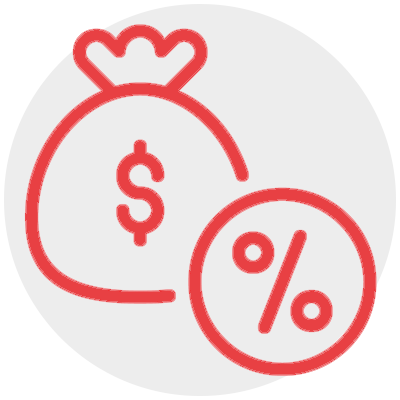We make property investing straightforward, so you can focus on growing your wealth with confidence! If you want to explore your options and understand key investment terms, download our Property Investment Guide today.
How investment property loans differ from owner-occupied loans
Investment property loans differ from owner-occupied home loans in structure, interest rates, and lending criteria. Here are the key distinctions:
Higher Interest Rates
Lenders generally apply higher interest rates to investment property loans due to the perceived risk, as rental income can fluctuate and properties may experience vacancy periods.
Rental Income Increases Borrowing Power
Lenders factor rental income into your overall earnings, which can enhance your borrowing capacity and potentially allow you to secure a larger loan.
Loan Terms & Repayment Options
Investment loans typically offer terms of up to 30 years, with flexible repayment structures:
- Interest-Only Loans: Lower monthly repayments by covering only interest, keeping cash flow high but not reducing the principal. This may offer tax benefits but results in higher long-term costs.
- Principal & Interest Loans: Gradually reduce the loan balance, helping you build equity in the property over time.
- Fixed vs. Variable Rates: Fixed rates provide predictable repayments, while variable rates fluctuate with the market, potentially affecting overall loan costs.
Selecting the right loan structure depends on your investment strategy and financial goals, making professional financial and tax advice essential.
Why are investor rates different from owner-occupier rates?
Investment home loans typically come with higher interest rates than owner-occupied loans due to the increased risk perceived by lenders. Several factors contribute to this:
These factors make investment properties a higher-risk category for lenders, resulting in increased costs for borrowers.
Using cross-collateralisation to access equity
Cross-collateralisation is a strategy where you use the equity in one property as security to finance the purchase of another. While this approach can help investors grow their portfolios without needing a large upfront deposit, it comes with potential risks:
A well-structured loan setup is crucial to managing these risks. A mortgage broker can help you explore alternatives and ensure your investment strategy aligns with your financial goals.
Stamp duty costs for investment properties
Stamp duty is a significant upfront cost when purchasing a property, and it is generally higher for investment properties than for owner-occupied homes. Here’s what investors should consider:
Stamp duty rates and policies vary by state, so it’s essential to stay informed about the latest regulations and assess how this cost affects your overall return on investment.
First home buyers purchasing an investment property
First home buyers can choose to purchase an investment property instead of an owner-occupied home, but this decision comes with important trade-offs:

Loss of first home buyer benefits
Government grants, stamp duty exemptions, and other incentives for first home buyers are typically only available for owner-occupied properties.

Long-term investment strategy
Some buyers opt to rent where they want to live while investing “rent-vest” in a more affordable property elsewhere. This approach can help build equity while maintaining lifestyle flexibility.
If you’re considering this strategy, a mortgage broker can help you understand the financial implications and lending options available.
Buying an investment property in a Self-Managed Super Fund (SMSF)
Purchasing an investment property through a Self-Managed Super Fund (SMSF) can be a powerful wealth-building strategy, but it comes with strict regulations and important considerations. SMSF property investment allows you to leverage your superannuation savings to invest in real estate while benefiting from tax advantages. However, this strategy requires careful planning, compliance with superannuation laws, and an understanding of the risks involved.
Key Considerations for Buying Property in an SMSF:
Strict lending criteria
Borrowing through an SMSF typically requires a Limited Recourse Borrowing Arrangement (LRBA), where the loan is secured against the investment property but does not put other SMSF assets at risk. Lenders often have higher deposit requirements (e.g., 20-30%) and stricter loan conditions.
Tax benefits
Rental income from an SMSF-owned property is taxed at a concessional rate of 15%, and capital gains tax (CGT) on properties held for over 12 months is reduced to 10%. If the SMSF is in the pension phase, tax on rental income and CGT may be eliminated entirely.
Restrictions on usage
You cannot live in or rent the SMSF property to yourself or related parties. It must be solely for investment purposes and meet the “sole purpose test” of providing retirement benefits to fund members.
Ongoing costs and compliance
SMSFs must adhere to strict reporting, auditing, and compliance obligations set by the Australian Taxation Office (ATO). Professional financial and legal advice is essential to ensure the SMSF remains compliant.
Liquidity and diversification risks
Property is an illiquid asset, meaning it may be difficult to sell if funds are needed. Investing too much of your super in one property could reduce diversification and increase risk.
Investing in property through an SMSF can be an effective long-term strategy, but it requires careful consideration. Consulting a financial adviser or SMSF specialist can help determine if it’s the right approach for your retirement goals
How UFinancial can help U.
Investing in property can be a powerful way to build wealth, but navigating the lending process can feel overwhelming. At UFinancial, we make securing an investment loan simple, ensuring you get the best possible finance solution to support your investment goals.
Expert guidance for smart investment decisions
With a team of over 60 finance professionals, we specialise in helping investors structure their loans effectively. Whether you’re purchasing your first investment property, expanding your portfolio, or leveraging equity for your next move, we provide tailored advice that aligns with your strategy.
Access to competitive investment loans
Choosing the right loan is crucial to maximising returns. UFinancial works with a vast network of lenders to compare hundreds of investment loan products, ensuring you secure the most competitive interest rates, loan structures, and features like interest-only repayments, offset accounts, and fixed or variable rates.
Beyond the loan – a holistic investment approach
Successful property investment is more than just securing finance. That’s why we offer insights into cash flow management, tax considerations, and loan structuring to help you make informed decisions. Our experts ensure your loan aligns with your long-term financial strategy.
No-cost, tailored support
Our services come at no cost to you. We’re paid by lenders, not clients, meaning you get expert guidance with no extra fees. Our goal is to help you secure the best loan for your investment—not push a particular lender’s product.
We’re with U, Australia-wide
Wherever you are in Australia, UFinancial is here to help. Whether you’re buying locally or expanding your portfolio interstate, our nationwide team provides seamless support to help you grow your investment success.
Investing in property is a big financial step, but you don’t have to do it alone. Let UFinancial make the process stress-free so you can focus on building wealth for the future.
Latest investment loan news
Frequently asked questions
We get asked a variety of questions, and here are some links to articles that address the ones that frequently pop up.

What is the difference between an investment property loan and a home loan?
Investment property loans typically come with higher interest rates and stricter lending criteria compared to home loans, as they are seen as higher-risk.

Can I use equity from my current home to invest in property?
Yes! Using the equity in your home is a common strategy to fund an investment property purchase.

How much deposit do I need for an investment property loan?
While deposit requirements vary, most lenders require at least a 20% deposit for investment properties.

Are there tax benefits to investing in property?
Property investors may be eligible for tax deductions on expenses like mortgage interest, repairs, and depreciation.

Can I purchase an investment property in a Self-Managed Super Fund (SMSF)?
Yes, investing in property through an SMSF is possible, but it comes with specific rules and requirements.

How does using cross- collateralisation work in property investing?
Cross-collateralisation involves using equity from multiple properties to secure a loan for further investments. While it can help grow your portfolio, it comes with risks.























